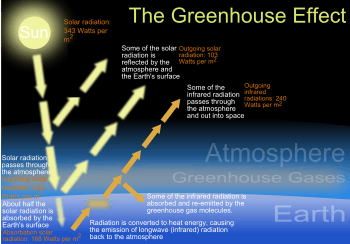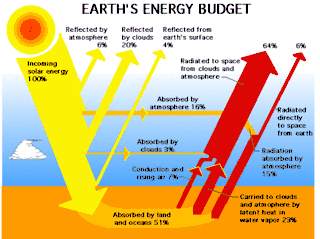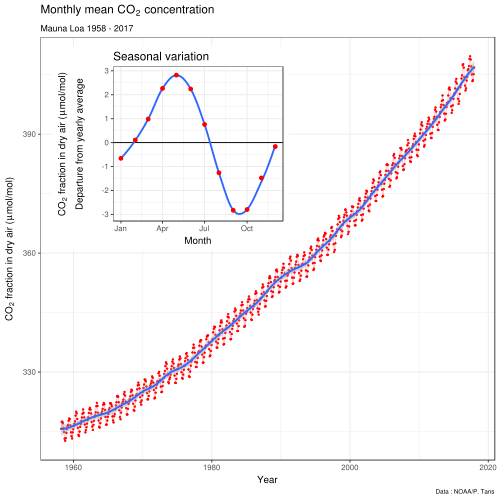Greenhouse effect



The greenhouse effect is the process by which radiation from a planet's atmosphere warms the planet's surface to a temperature above what it would be without its atmosphere.[1][2]
If a planet's atmosphere contains radiatively active gases (i.e., greenhouse gases) they will radiate energy in all directions. Part of this radiation is directed towards the surface, warming it.[3] The intensity of the downward radiation – that is, the strength of the greenhouse effect – will depend on the atmosphere's temperature and on the amount of greenhouse gases that the atmosphere contains.
Earth’s natural greenhouse effect is critical to supporting life. Human activities, mainly the burning of fossil fuels and clearing of forests, have strengthened the greenhouse effect and caused global warming.[4]
The term "greenhouse effect" arose from a faulty analogy with the effect of sunlight passing through glass and warming a greenhouse. The way a greenhouse retains heat is fundamentally different, as a greenhouse works mostly by reducing airflow so that warm air is kept inside.[2][5][6]
History
The existence of the greenhouse effect was argued for by Joseph Fourier in 1824. The argument and the evidence were further strengthened by Claude Pouillet in 1827 and 1838 and reasoned from experimental observations by John Tyndall in 1859, who measured the radiative properties of specific greenhouse gases.[7] The effect was more fully quantified by Svante Arrhenius in 1896, who made the first quantitative prediction of global warming due to a hypothetical doubling of atmospheric carbon dioxide.[8] However, the term "greenhouse" was not used to refer to this effect by any of these scientists; the term was first used in this way by Nils Gustaf Ekholm in 1901.[9][10]
Mechanism
Earth receives energy from the Sun in the form of ultraviolet, visible, and near-infrared radiation. About 26% of the incoming solar energy is reflected to space by the atmosphere and clouds, and 19% is absorbed by the atmosphere and clouds. Most of the remaining energy is absorbed at the surface of Earth. Because the Earth's surface is colder than the Sun, it radiates at wavelengths that are much longer than the wavelengths that were absorbed. Most of this thermal radiation is absorbed by the atmosphere and warms it. The atmosphere also gains heat by sensible and latent heat fluxes from the surface. The atmosphere radiates energy both upwards and downwards; the part radiated downwards is absorbed by the surface of Earth. This leads to a higher equilibrium temperature than if the atmosphere were absent.

An ideal thermally conductive blackbody at the same distance from the Sun as Earth would have a temperature of about 5.3 °C (41.5 °F). However, because Earth reflects about 30%[11][12] of the incoming sunlight, this idealized planet's effective temperature (the temperature of a blackbody that would emit the same amount of radiation) would be about −18 °C (0 °F).[13][14] The surface temperature of this hypothetical planet is 33 °C (91 °F) below Earth's actual surface temperature of approximately 14 °C (57 °F).[15]
The basic mechanism can be qualified in a number of ways, none of which affect the fundamental process. The atmosphere near the surface is largely opaque to thermal radiation (with important exceptions for "window" bands), and most heat loss from the surface is by sensible heat and latent heat transport. Radiative energy losses become increasingly important higher in the atmosphere, largely because of the decreasing concentration of water vapor, an important greenhouse gas. It is more realistic to think of the greenhouse effect as applying to a "surface" in the mid-troposphere, which is effectively coupled to the surface by a lapse rate. The simple picture also assumes a steady state, but in the real world, there are variations due to the diurnal cycle as well as the seasonal cycle and weather disturbances. Solar heating only applies during daytime. During the night, the atmosphere cools somewhat, but not greatly, because its emissivity is low. Diurnal temperature changes decrease with height in the atmosphere.
Within the region where radiative effects are important, the description given by the idealized greenhouse model becomes realistic. Earth's surface, warmed to a temperature around 255 K, radiates long-wavelength, infrared heat in the range of 4–100 μm.[16] At these wavelengths, greenhouse gases that were largely transparent to incoming solar radiation are more absorbent.[16] Each layer of atmosphere with greenhouses gases absorbs some of the heat being radiated upwards from lower layers. It reradiates in all directions, both upwards and downwards; in equilibrium (by definition) the same amount as it has absorbed. This results in more warmth below. Increasing the concentration of the gases increases the amount of absorption and reradiation, and thereby further warms the layers and ultimately the surface below.[14]
Greenhouse gases—including most diatomic gases with two different atoms (such as carbon monoxide, CO) and all gases with three or more atoms—are able to absorb and emit infrared radiation. Though more than 99% of the dry atmosphere is IR transparent (because the main constituents—N
2, O
2, and Ar—are not able to directly absorb or emit infrared radiation), intermolecular collisions cause the energy absorbed and emitted by the greenhouse gases to be shared with the other, non-IR-active, gases.
Greenhouse gases
By their percentage contribution to the greenhouse effect on Earth the four major gases are:[17][18]

- water vapor, 36–70%
- carbon dioxide, 9–26%
- methane, 4–9%
- ozone, 3–7%
It is not possible to assign a specific percentage to each gas because the absorption and emission bands of the gases overlap (hence the ranges given above). Clouds also absorb and emit infrared radiation and thus affect the radiative properties of the atmosphere.[18]
Role in climate change

Strengthening of the greenhouse effect through human activities is known as the enhanced (or anthropogenic) greenhouse effect.[20] This increase in radiative forcing from human activity is attributable mainly to increased atmospheric carbon dioxide levels.[21] According to the latest Assessment Report from the Intergovernmental Panel on Climate Change, "atmospheric concentrations of carbon dioxide, methane and nitrous oxide are unprecedented in at least the last 800,000 years. Their effects, together with those of other anthropogenic drivers, have been detected throughout the climate system and are extremely likely to have been the dominant cause of the observed warming since the mid-20th century".[22]
CO2 is produced by fossil fuel burning and other activities such as cement production and tropical deforestation.[23] Measurements of CO2 from the Mauna Loa observatory show that concentrations have increased from about 313 parts per million (ppm)[24] in 1960 to about 389 ppm in 2010. It reached the 400 ppm milestone on May 9, 2013.[25] The current observed amount of CO2 exceeds the geological record maxima (~300 ppm) from ice core data.[26] The effect of combustion-produced carbon dioxide on the global climate, a special case of the greenhouse effect first described in 1896 by Svante Arrhenius, has also been called the Callendar effect.
Over the past 800,000 years,[27] ice core data shows that carbon dioxide has varied from values as low as 180 ppm to the pre-industrial level of 270 ppm.[28] Paleoclimatologists consider variations in carbon dioxide concentration to be a fundamental factor influencing climate variations over this time scale.[29][30]
Real greenhouses
The "greenhouse effect" of the atmosphere is named by analogy to greenhouses which become warmer in sunlight. However, a greenhouse is not primarily warmed by the "greenhouse effect".[31] "Greenhouse effect" is actually a misnomer since heating in the usual greenhouse is due to the reduction of convection,[32] while the "greenhouse effect" works by preventing absorbed heat from leaving the structure through radiative transfer.
A greenhouse is built of any material that passes sunlight usually glass, or plastic. The sun warms the ground and contents inside just like the outside, which then warms the air. Outside, the warm air near the surface rises and mixes with cooler air aloft, keeping the temperature lower than inside, where the air continues to heat up because it is confined within the greenhouse. This can be demonstrated by opening a small window near the roof of a greenhouse: the temperature will drop considerably. It was demonstrated experimentally (R. W. Wood, 1909) that a (not heated) "greenhouse" with a cover of rock salt (which is transparent to infrared) heats up an enclosure similarly to one with a glass cover.[6] Thus greenhouses work primarily by preventing convective cooling.[5]
Heated greenhouses are yet another matter, having an internal source of heating they leak heat out, which must be prevented. So it again makes sense to try to prevent radiative cooling through the use of adequate glazing.[33]
Related effects
Anti-greenhouse effect
The anti-greenhouse effect is a mechanism similar and symmetrical to the greenhouse effect: greenhouse effect is about atmosphere letting radiation in, while not letting thermal radiation out, which warms the body surface; anti-greenhouse effect is about atmosphere NOT letting radiation in, while letting thermal radiation out, which lowers the equilibrium surface temperature. Such an effect has been cited about Titan[34]
Runaway greenhouse effect
A runaway greenhouse effect occurs if positive feedbacks lead to the evaporation of all greenhouse gases into the atmosphere.[35] A runaway greenhouse effect involving carbon dioxide and water vapor has long ago been hypothesized to have occurred on Venus,[36] this idea is still largely accepted.
Bodies other than Earth
The greenhouse effect on Venus is particularly large because its dense atmosphere consists mainly of carbon dioxide.[37] "Venus experienced a runaway greenhouse in the past, and we expect that Earth will in about 2 billion years as solar luminosity increases".[38]
Titan has an anti-greenhouse effect, in that its atmosphere absorbs solar radiation but is relatively transparent to outgoing infrared radiation.
Pluto is also colder than would be expected because evaporation of nitrogen cools it.[39]
See also
References
- ↑ "Annex II Glossary". Intergovernmental Panel on Climate Change. Retrieved 15 October 2010.
- 1 2 A concise description of the greenhouse effect is given in the Intergovernmental Panel on Climate Change Fourth Assessment Report, "What is the Greenhouse Effect?" FAQ 1.3 – AR4 WGI Chapter 1: Historical Overview of Climate Change Science, IIPCC Fourth Assessment Report, Chapter 1, page 115: "To balance the absorbed incoming [solar] energy, the Earth must, on average, radiate the same amount of energy back to space. Because the Earth is much colder than the Sun, it radiates at much longer wavelengths, primarily in the infrared part of the spectrum (see Figure 1). Much of this thermal radiation emitted by the land and ocean is absorbed by the atmosphere, including clouds, and reradiated back to Earth. This is called the greenhouse effect."
Schneider, Stephen H. (2001). "Global Climate Change in the Human Perspective". In Bengtsson, Lennart O.; Hammer, Claus U. Geosphere-biosphere Interactions and Climate. Cambridge University Press. pp. 90–91. ISBN 0-521-78238-4.
Claussen, E.; Cochran, V.A.; Davis, D.P., eds. (2001). "Global Climate Data". Climate Change: Science, Strategies, & Solutions. University of Michigan. p. 373. ISBN 9004120246.
Allaby, A.; Allaby, M. (1999). A Dictionary of Earth Sciences. Oxford University Press. p. 244. ISBN 0-19-280079-5. - ↑ Vaclav Smil (2003). The Earth's Biosphere: Evolution, Dynamics, and Change. MIT Press. p. 107. ISBN 978-0-262-69298-4.
- ↑ IPCC AR4 WG1 (2007), Solomon, S.; Qin, D.; Manning, M.; Chen, Z.; Marquis, M.; Averyt, K.B.; Tignor, M.; Miller, H.L., eds., Climate Change 2007: The Physical Science Basis, Contribution of Working Group I to the Fourth Assessment Report of the Intergovernmental Panel on Climate Change, Cambridge University Press, ISBN 978-0-521-88009-1 (pb: 978-0-521-70596-7)
- 1 2
Schroeder, Daniel V. (2000). An introduction to thermal physics. Addison-Wesley. pp. 305–7. ISBN 0-321-27779-1.
... this mechanism is called the greenhouse effect, even though most greenhouses depend primarily on a different mechanism (namely, limiting convective cooling).
- 1 2 Wood, R.W. (1909). "Note on the Theory of the Greenhouse". Philosophical Magazine. 17: 319–320. doi:10.1080/14786440208636602.
When exposed to sunlight the temperature rose gradually to 65 °C., the enclosure covered with the salt plate keeping a little ahead of the other because it transmitted the longer waves from the Sun, which were stopped by the glass. In order to eliminate this action the sunlight was first passed through a glass plate." "it is clear that the rock-salt plate is capable of transmitting practically all of it, while the glass plate stops it entirely. This shows us that the loss of temperature of the ground by radiation is very small in comparison to the loss by convection, in other words that we gain very little from the circumstance that the radiation is trapped.
- ↑ John Tyndall, Heat considered as a Mode of Motion (500 pages; year 1863, 1873)
- ↑ Held, Isaac M.; Soden, Brian J. (November 2000). "Water Vapor Feedback and Global Warming". Annual Review of Energy and the Environment. Annual Reviews. 25: 441–475. doi:10.1146/annurev.energy.25.1.441.
- ↑ Easterbrook, Steve. "Who first coined the term "Greenhouse Effect"?". Serendipity. Retrieved 11 November 2015.
- ↑ Ekholm N (1901). "On The Variations Of The Climate Of The Geological And Historical Past And Their Causes". Quarterly Journal of the Royal Meteorological Society. 27 (117): 1–62. Bibcode:1901QJRMS..27....1E. doi:10.1002/qj.49702711702.
- ↑ "NASA Earth Fact Sheet". Nssdc.gsfc.nasa.gov. Retrieved 2010-10-15.
- ↑ Jacob, Daniel J. (1999). "7. The Greenhouse Effect". Introduction to Atmospheric Chemistry. Princeton University Press. ISBN 1400841542. Retrieved 2010-10-15.
- ↑ "Solar Radiation and the Earth's Energy Balance". Eesc.columbia.edu. Retrieved 2010-10-15.
- 1 2 Intergovernmental Panel on Climate Change Fourth Assessment Report. Chapter 1: Historical overview of climate change science page 97
- ↑ The elusive "absolute surface air temperature," see GISS discussion
- 1 2 Mitchell, John F. B. (1989). "The "Greenhouse" effect and Climate Change" (PDF). Reviews of Geophysics. American Geophysical Union. 27 (1): 115–139. Bibcode:1989RvGeo..27..115M. doi:10.1029/RG027i001p00115. Retrieved 2008-03-23.
- ↑ "Water vapour: feedback or forcing?". RealClimate. 6 April 2005. Retrieved 2006-05-01.
- 1 2 Kiehl, J.T.; Trenberth, Kevin E. (February 1997). "Earth's Annual Global Mean Energy Budget" (PDF). Bulletin of the American Meteorological Society. 78 (2): 197–208. Bibcode:1997BAMS...78..197K. doi:10.1175/1520-0477(1997)078<0197:EAGMEB>2.0.CO;2. Archived from the original (PDF) on 2006-03-30. Retrieved 2006-05-01.
- ↑ "NASA: Climate Forcings and Global Warming". January 14, 2009.
- ↑ "Enhanced greenhouse effect — Glossary". Nova. Australian Academy of Scihuman impact on the environment. 2006.
- ↑ "Enhanced Greenhouse Effect". Ace.mmu.ac.uk. Archived from the original on 2010-10-24. Retrieved 2010-10-15.
- ↑ "Synthesis Report: Summary for Policymakers" (PDF). IPCC Fifth Assessment Report. p. 4.
- ↑ IPCC Fourth Assessment Report, Working Group I Report "The Physical Science Basis" Chapter 7
- ↑ "Atmospheric Carbon Dioxide – Mauna Loa". NOAA.
- ↑ "Climate Milestone: Earth's CO2 Level Passes 400 ppm". National Geographic. 2013-05-12. Retrieved 2017-12-10.
- ↑ Hansen J. (February 2005). "A slippery slope: How much global warming constitutes "dangerous anthropogenic interference"?". Climatic Change. 68 (333): 269–279. doi:10.1007/s10584-005-4135-0.
- ↑ "Deep ice tells long climate story". BBC News. 2006-09-04. Retrieved 2010-05-04.
- ↑ Hileman B (2005-11-28). "Ice Core Record Extended". Chemical & Engineering News. 83 (48): 7.
- ↑ Bowen, Mark (2006). Thin Ice: Unlocking the Secrets of Climate in the World's Highest Mountains. Owl Books,. ISBN 1429932708.
- ↑ Temperature change and carbon dioxide change, U.S. National Oceanic and Atmospheric Administration
- ↑ Brian Shmaefsky (2004). Favorite demonstrations for college science: an NSTA Press journals collection. NSTA Press. p. 57. ISBN 978-0-87355-242-4.
- ↑ Oort, Abraham H.; Peixoto, José Pinto (1992). Physics of climate. New York: American Institute of Physics. ISBN 0-88318-711-6.
...the name water vapor-greenhouse effect is actually a misnomer since heating in the usual greenhouse is due to the reduction of convection
- ↑ Kurpaska, Sławomir (2014). "Energy effects during using the glass with different properties in a heated greenhouse" (PDF). Technical Sciences. 17 (4): 351–360.
- ↑ "Titan: Greenhouse and Anti-greenhouse". Astrobiology Magazine – earth science – evolution distribution Origin of life universe – life beyond :: Astrobiology is study of earth. Retrieved 2010-10-15.
- ↑ Kasting, James F. (1991). "Runaway and moist greenhouse atmospheres and the evolution of Earth and Venus.". Planetary Sciences: American and Soviet Research/Proceedings from the U.S.-U.S.S.R. Workshop on Planetary Sciences. Commission on Engineering and Technical Systems (CETS). pp. 234–245. Retrieved 9 April 2017.
- ↑ Rasool, I.; De Bergh, C. (June 1970). "The Runaway Greenhouse and the Accumulation of CO2 in the Venus Atmosphere" (PDF). Nature. 226 (5250): 1037–9. Bibcode:1970Natur.226.1037R. doi:10.1038/2261037a0. PMID 16057644. Archived from the original (PDF) on 2011-10-21.
- ↑ McKay, C.; Pollack, J.; Courtin, R. (1991). "The greenhouse and antigreenhouse effects on Titan". Science. 253 (5024): 1118–21. doi:10.1126/science.11538492. PMID 11538492.
- ↑ Goldblatt, Colin; Watson, Andrew J. (2012). "The Runaway Greenhouse: Implications for Future Climate Change, Geoengineering and Planetary Atmospheres". Philosophical Transactions of the Royal Society of London A: Mathematical, Physical and Engineering Sciences. 370 (1974): 4197–4216. JSTOR 41582871.
- ↑ "Pluto Colder Than Expected". SPACE.com. 2006-01-03. Retrieved 2010-10-15.
Further reading
- Businger, Joost Alois; Fleagle, Robert Guthrie (1980). An introduction to atmospheric physics. International Geophysics (2nd ed.). Academic. ISBN 0-12-260355-9.
- Henderson-Sellers, Ann; McGuffie, Kendal (2005). A climate modelling primer (3rd ed.). Wiley. ISBN 0-470-85750-1.
- Schelling, Thomas C. (2002). "Greenhouse Effect". In Henderson, David R. Concise Encyclopedia of Economics (1st ed.). Library of Economics and Liberty. OCLC 317650570, 50016270, 163149563